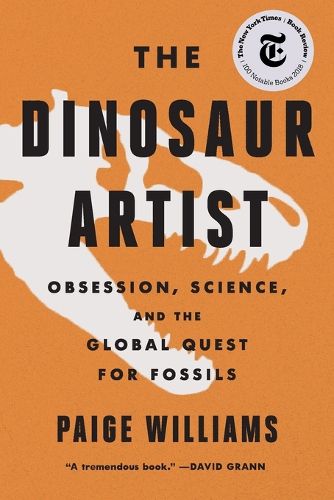The Dinosaur Artist
Paige Williams

The Dinosaur Artist
Paige Williams
In 2012, a New York auction catalogue boasted an unusual offering: a superb Tyrannosaurus skeleton. In fact, Lot 49135 consisted of a nearly complete T. bataar, a close cousin to the most famous animal that ever lived. The fossils now on display in a Manhattan event space had been unearthed in Mongolia, more than 6,000 miles away. At eight-feet high and twenty-four feet long, the specimen was spectacular, and when the gavel sounded, the winning bid was over $1 million.
Eric Prokopi, a thirty-eight-year-old Floridian, was the man who had brought this extraordinary skeleton to market. A onetime collegiate-level swimmer who spent his teenage years diving for shark teeth, Prokopi’s singular obsession with fossils fueled a thriving business hunting, preparing, and selling specimens, to clients ranging from natural history museums to avid private collectors like actors Leonardo DiCaprio and Nicolas Cage.
But there was a problem. This time, facing financial strain, had Prokopi gone too far? As the T. bataar went to auction, a network of paleontologists alerted the government of Mongolia to the eye-catching lot. An international custody battle ensued, and Prokopi watched his own world unravel.
In the tradition of The Orchid Thief, The Dinosaur Artist is a stunning work of narrative journalism about humans’ relationship with natural history and a seemingly intractable conflict between science and commerce.
Review
Julia Jackson
Adapted and greatly expanded from her 2013 New Yorker article ‘Bones of Contention’, Paige Williams delves again, more deeply, into the heady and complex world of ‘commercial palaeontology’ and its implications regarding national cultural heritage. The crux of this book (at its literal, paginated heart) is the case that resulted in dinosaur enthusiast Eric Prokopi’s conviction for illegally smuggling a (whole) skeleton of the Tarbosaurus bataar (the Asian variant of T-Rex) into the United States from Mongolia, via the UK, having falsified the customs declaration. Mongolia’s constitution, as it happens, stipulates that dinosaur and other fossil finds are culturally significant and national property. Thus T. bataar was seized and repatriated. But before we even get to this juicy bit, Williams unpacks the international socio-historical context and legislative frameworks (or lack thereof) that underpin the collection and distribution of palaeontological material.
Throughout the first half she introduces readers to key events and historical figures such as Mary Anning, Marsh and Cope, and Roy Chapman Andrews (long touted as the inspiration for the character of Indiana Jones), as well as the contemporary shady and legitimate collector-dealers who, even with all good intentions to promote the study of our planet’s former inhabitants, ignore cultural heritage frameworks in their quest for big dollars. Admittedly, the USA was perhaps a bit late to the party here: only in 2009 did their government introduce legislation to control this, by mandating permits and issuing them to scientists and museum affiliates. While the content of this book is fascinating, the structure is layered (think geological strata) and perhaps suffers from being too detailed and rambling. Not for the faint-hearted, it is nevertheless an ambitious and worthy addition to the natural history and science-writing canon, and also to national cultural heritage literature.
Julia Jackson is the assistant shop manager at Readings Carlton.
This item is not currently in-stock. It can be ordered online and is expected to ship in approx 2 weeks
Our stock data is updated periodically, and availability may change throughout the day for in-demand items. Please call the relevant shop for the most current stock information. Prices are subject to change without notice.
Sign in or become a Readings Member to add this title to a wishlist.


